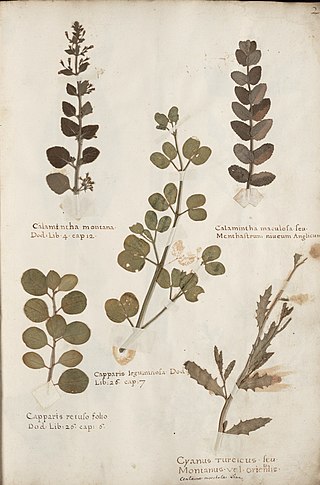
A herbarium is a collection of preserved plant specimens and associated data used for scientific study.

Elmer Drew Merrill was an American botanist and taxonomist. He spent more than twenty years in the Philippines where he became a recognized authority on the flora of the Asia-Pacific region. Through the course of his career he authored nearly 500 publications, described approximately 3,000 new plant species, and amassed over one million herbarium specimens. In addition to his scientific work he was an accomplished administrator, college dean, university professor and editor of scientific journals.

Rhaphidophora is a genus in the family Araceae, occurring from tropical Africa eastwards through Malesia and Australasia to the Western Pacific. The genus consists of approximately 100 species.

Homalomena is a genus of flowering plants in the family Araceae. Homalomena are found in southern Asia and the southwestern Pacific. Many Homalomena have a strong smell of anise. The name derives apparently from a mistranslated Malayan vernacular name, translated as homalos, meaning flat, and mene = moon.
Carl Adolf Georg Lauterbach was a German explorer and botanist.

Digitalis davisiana is a species of foxglove, a herbaceous plant in the genus Digitalis in the family Plantaginaceae, formerly in the Scrophulariaceae and briefly the Veronicaceae. It is native to Turkey.

Bikkia tetrandra is an herbaceous member of the family Rubiaceae, distinguished by its white square-shaped flowers. It is native to Papuasia and islands of the western Pacific, including the Caroline Islands, Fiji, Mariana Islands, New Caledonia, New Guinea, Niue, Solomon Islands, Tonga, Vanuatu, and Wallis-Futuna Islands. The stems ignite easily and can be used to make torches or candles.
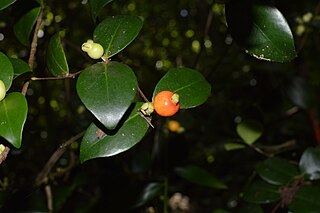
Eugenia palumbis is a shrub with edible fruits in the family Myrtaceae. It is endemic to the Mariana Islands, including Guam and the Commonwealth of the Northern Mariana Islands.
Cedric Errol Carr was a New Zealand botanist, specialising in orchids. At the age of seven he went to England with his family but from January 1913 until 1931, apart from military service from 1916 to 1918, he worked on rubber plantations in Malaya.
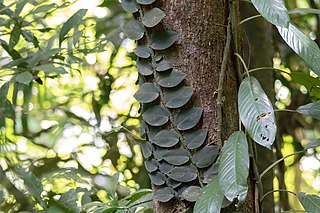
Rhaphidophora hayi is a species of flowering plant in the arum family Araceae, native to Queensland and New Guinea. It is an appressed or shingling semi-epiphytic vining plant that grows in wet tropical forests.

Symphyotrichum lucayanum is a species of flowering plant of the aster family (Asteraceae) endemic to the North American island of Grand Bahama.
Eryl Smith was a Welsh doctor, botanist and plant collector. She completed her medical training at the London School of Medicine for Women and the Royal Free Hospital. After moving with her husband, Dr. Malcolm Smith, to Siam, she became interested in botany and plant collecting. From 1921 to 1925, she collected plants for the British Museum herbarium. Later, she worked at the Royal Botanic Gardens, Kew, completing work on the ferns of Thailand.

Syzygium thompsonii is an endemic tree of the Mariana Islands of Guam, Rota, and Saipan with a striking appearance due to its abundance of white flowers and edible fruit that grow directly from the trunk. It is related to the Malay apple but bears smaller tart fruit.
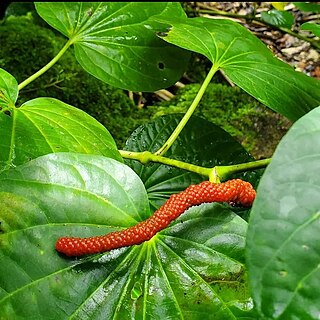
Piper guahamense, the Guam pepper, is a plant in the family Piperaceae, and is endemic to the Mariana Islands.

Piper salicinum is a plant in the Piperaceae family that is possibly endemic to the Mariana Islands (Guam), although there is some confusion in the literature as to whether it may have been collected from Mexico and Panama. It has not been observed since its initial collection in 1792.
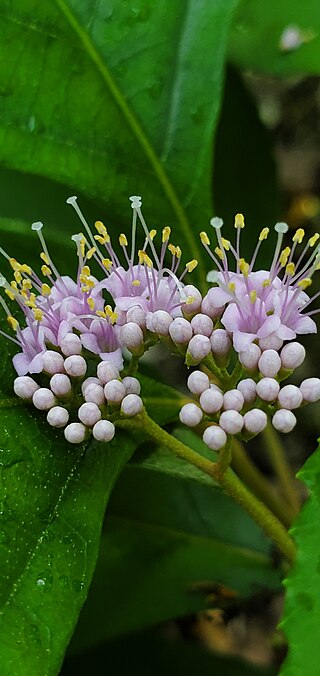
Callicarpa lamii is a plant in the mint family that is endemic to the Mariana Islands. It is one of two Callicarpa plants endemic to the Mariana Islands, the other being Callicarpa candicans var. paucinervia.

Myosotis australissubsp. saruwagedica is a subspecies of flowering plant in the family Boraginaceae, endemic to New Guinea. August Brand described the species M. saruwagedica in 1929 and it was considered to be a synonym or a subspecies of M. australis by subsequent authors. Plants of this subspecies of forget-me-not are perennial rosettes with ebracteate inflorescences and white or yellow corollas with stamens that are fully included in the corolla tube or sometimes partly protruded.

Leptecophylla mariannensis is a plant in the Ericaceae family and is only known to exist on the tiny island of Alamagan in the Mariana archipelago.

Rhaphidophora petrieana is a plant in the arum family Araceae that is only found in the Wet Tropics bioregion of northeastern Queensland, Australia.



















